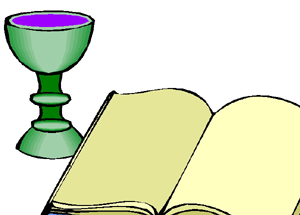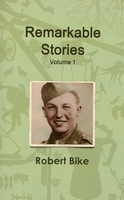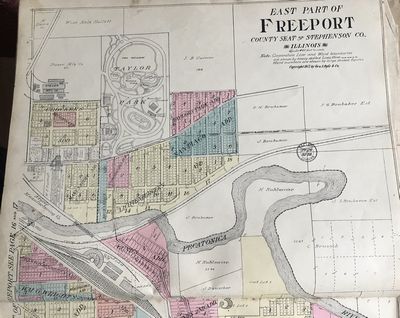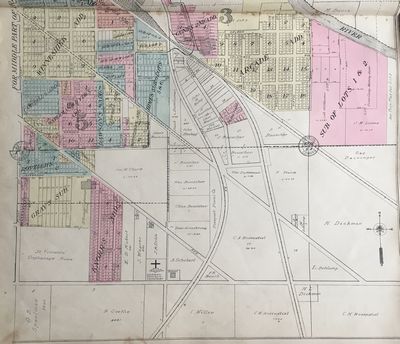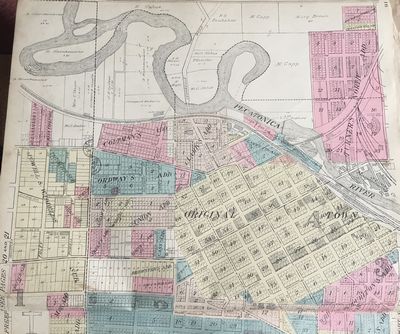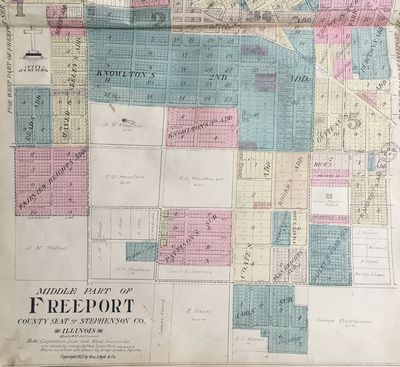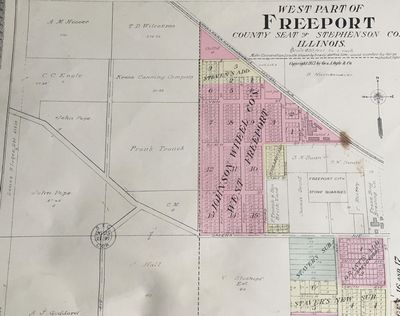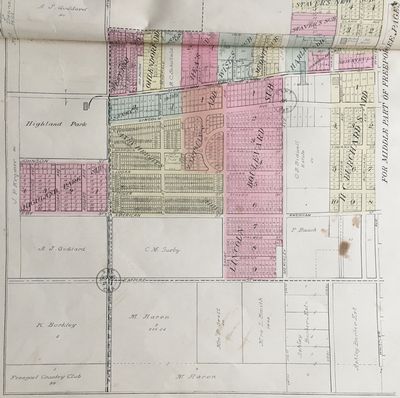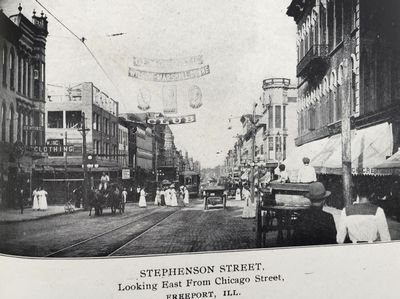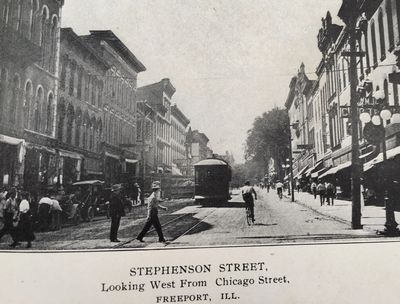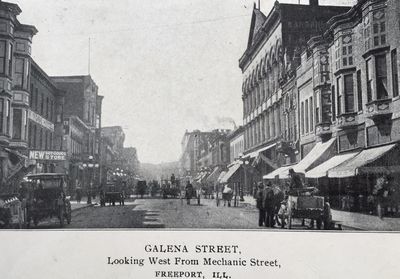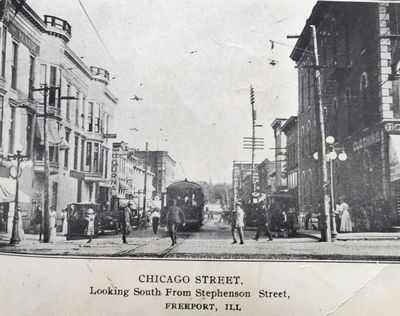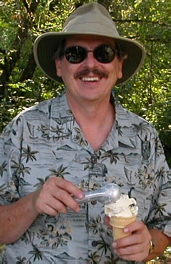
Robert Bike
Licensed
Massage Therapy #5473
Eugene, Oregon
EFT-CC, EFT-ADV
Teaching Reiki Master
Life Coach
|
Reiki
Private classes. |
|
Member
OMTA & ABMP President of the Oregon Massage Therapists Association 2008-2010 & 2012-2013 |
|
I
graduated from Freeport (Illinois) High School. |
|
Please
help keep
this site free. Buy one of my books, on sale below. All sales go to help support this website. |
|
Remarkable
Stories, Remarkable
events have happened in Freeport and Stephenson County, Illinois,
and remarkable people have lived there. These are stories gathered
about people and events from 1835 through World War II. |
|
Biblical
Aromatherapy
by Robert Bike 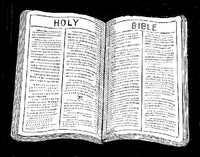
The Bible mentions about 232 plants by name, or closely enough to figure out what plant is meant. Of these, 24 are aromatic plants; that is, parts of the plants can be pressed or distilled to get an essential oil. Essential oils are the lifeblood of plants and have tremendous healing capabilities. The
healing power of plants is the basis for modern medicines.
Originally published in manuscript form in 1999, I completely revised the book and added illustrations. To order
Biblical Aromatherapy in paperback, List price $24.99; introductory offer $19.99 To order the pdf version and download to your computer or phone, The electronic version is only $2.99! |
Publicity!
|
Olga
Carlile, columnist for the Freeport (Illinois) Journal Standard,
featured this website in her column on January 19, 2007. |
|
Harriet
Gustason, another columnist for the Freeport Journal Standard,
has featured this website twice. Click to see pdf of articles:
June 29, 2012 November 3, 2012 |
|
"My
Life Purpose is to inspire my friends |
Robert Bike, LMT, LLC
The Class of 1913
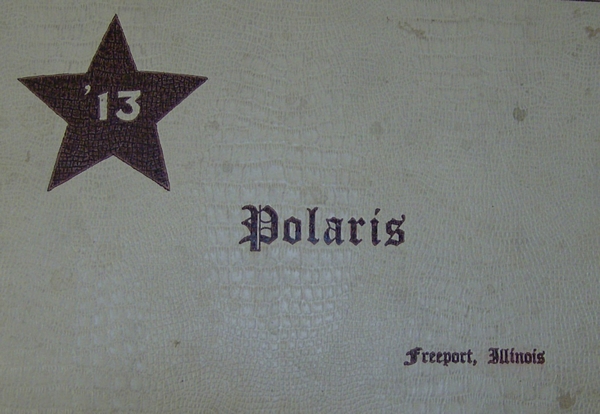
Max Antrim, Gladys Andres,
Lillian Barrett, Lola Baymiller, Mae Bean, Brace Beeler, Helen Berry, Beryl Bertalot, Robert Betts, Henry Biersach, Jeanette Borgmeier, Raymond Britt, Angelina Brockmeier, Bethel Brown, Minnie Brunnemer, Charles Malcolm Byerly,
Lloyd Clifford, Bessie Craiger, Leslie H. Crockett,
Leonard Davis, Mary DeBeer, Louise Dittman,
Cathryn Farnum, Leone Fetterhof, Lawrence Fisher, Vera Foss, John Frank,
Herbert Grattelo,
Alta Haithcox, Zella Harnish, Dorothy Hettinger,
Hazel Ifert,
William Jungkunz,
Jennie Kahl, Marcie Kennison, Hugh Kleckner, Vernon Klontz, Ruth Knoble, Vivian Kostenbader,
Mary Lacy, Robert Langenstein, Frances Lavelle, Harriet Lennox, Arthur Lentz, Henry Lichtenberger, Lee Lonnergan, Bessie Luce, Edith Lyon,
Charles Markel, Esther Matter, Enolia McCluhan, Eleanor McClurkin, Elmer McCool, Marie Merck, Viola Meyers, Weber Meyers, Ellsworth Mulnix,
Julius Nix,
Agnes Osborn,
John Petrie, Marie Pfeil, J. Maurice Phillips, Wilma Pierce, Jean Place, Luella Powell, Bert Prall,
Muriel Rice, Leonora Rideout, Thomas Rigney, Oscar Rippberger, Katheryn Royer, Edwin Ryan,
Helen Schulte, Marie Schulte, Iola Schulz, Newell Sensanbaugh, Lloyd Sensenbaug, Ethel Shearer, Kurt Siecke, Ruth Smith, Sidney Smith, Clarence Snyder, Harold Snyder, Vida Snyder, Blanche Soper, Gertrude Stadel, Alex Steenrod, Ralph Stein, Harry Stine, Mildred Swartz,
Lois Taggart, Clarice Taylor, Robin Thomas,
Irene Ulrich,
Amanda Vaupel,
Flossie Wagner, Winnifred Wareham, Fred Wheat, Mary Wilson,
Edward D. Young, Gladys Youngblutl.
World War I Veterans from the Class of 1913
Ensign Max Antrim served with the U.S. Merchant Marine, Atlantic Service.
Raymond Britt was a Chief Quartermaster, Naval Aviation, U.S. Navy Hospital Corps, from June 1917 to December 1918.
Charles Malcolm Byerly was in Officer's Training School at Camp Grant, Rockford.
Lloyd Clifford served in the U.S. Navy aboard the Battleship "St. Louis."
Leslie H. Crockett was in the U. S. Naval Reserve Force attached to the "Norman B. Ream" and the "U.S.S. Mayflower."
Lieutenant Leonard Davis was in the Artillery at Fortress Rosecranz, San Diego, California.
Lawrence Fisher served with an Ambulance Unit in Italy.
Corporal Herbert Grattelo served with the U.S. Cavalry in Texas.
Sergeant William Jungkunz served in the Quartermaster's Department, Salvage Company 1, at Camp Kearny California.
Sergeant Hugh Kleckner was with the 342 Infantry, overseas.
Vernon Klontz was in Ensign School with the Navy at Municipal Pier, Chicago.
Arthur Lentz served in the army.
Robert Langenstein served in the Infantry. He was Killed in Action.
Henry Lichtenberger served with the 17th Company, C.A.C., at Fort Williams in Portland, Maine.
Charles Markel served with the First Division, Aero Squadron, at Ellington Field in Houston, Texas.
Sergeant Elmer McCool was in the Infantry.
J. Maurice Phillips enlisted in the Navy in June of 1917 and served on board the "Hancock."
Bert Prall was a Quartermaster at Newport, Rhode Island.
Edwin Ryan served in the Navy.
Newell Sensanbaugh was a Private in the Marine Corps. He was sent to Paris Island and Quantico, Virginia.
Lieutenant Kurt Siecke served with the Signal Corps.
Clarence Snyder served with the Truck Corps.
Harold Snyder was a Private at Headquarters Company, 13th Regiment, F.A.R.D., Camp Jackson, South Carolina.
Alex Steenrod trained at the Coast Artillery Officer's Training Camp.
Harry Stine served with the Quartermaster's Department in Philadelphia, Pennsylvania.
Fred Wheat served in the Infantry, Fort George, Spokane, Washington.
Edward D. Young was in Officers Training Camp, Jos. E. Johnston, Florida.
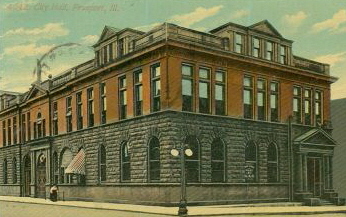
Freeport City Hall, as shown on a card postmarked in 1913, was located at the northeast corner of Stephenson & Walnut.
The cornerstone was laid in 1899. The architect, D. S, Schureman asked that his name be put on the building, but city officials refused. Determined to put his name on the building, Schureman suggested that since the building would initially house the library, that the names of famous literary figures be put on the cornice. The mayor and city council liked that idea.
The architect selected Dante, Shakespeare, Spencer, Chaucer, Homer, Uhland, Rabelais, Emerson, Milton, Addison, and Newton. Coincidentally, the first letters of those authors spelled out the architect's name!
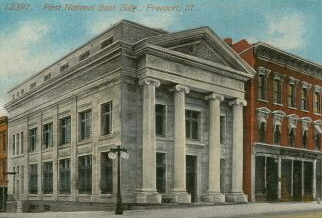
First National Bank in 1913.
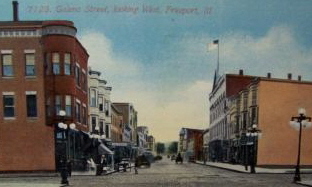
Galena Street, now known as Main Street.
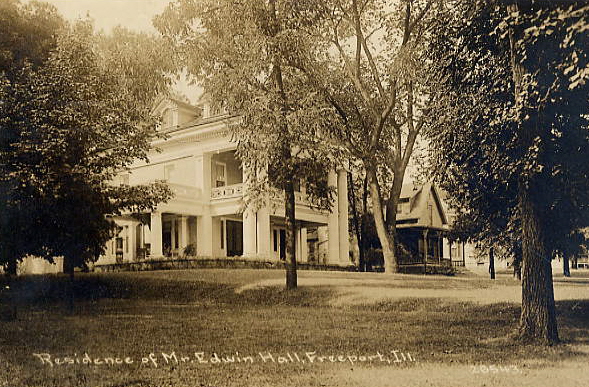
Not only were public buildings the subject of postcards in the early 20th century, but apparently some private residences were worthy as well. Shown on a card postmarked in 1913 is the residence of Mr. Edwin Hall. This house is located on W. Stephenson Street. Hall was a director of the Security Trust Company, located in the Tarbox Building.
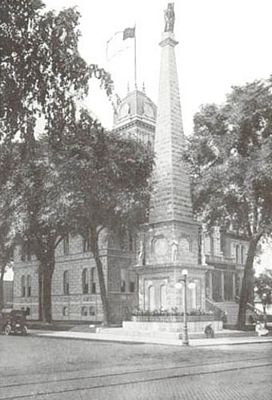
The Stephenson County Courthouse and Soldiers' Monument. Note the bricks of Stephenson Street, the trolley tracks, a street lamp, and a couple of people sitting on the wall.
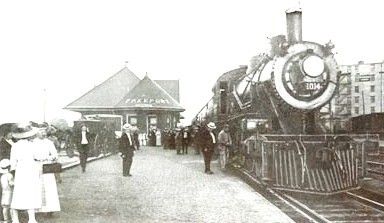
The Illinois Central Railroad depot, with steam engine number 1034.
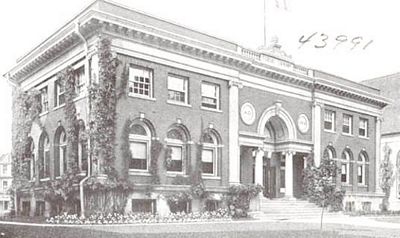
The Freeport Public Library.
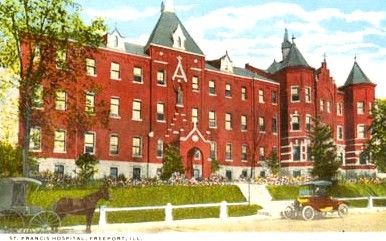
St. Francis Hospital in 1913.
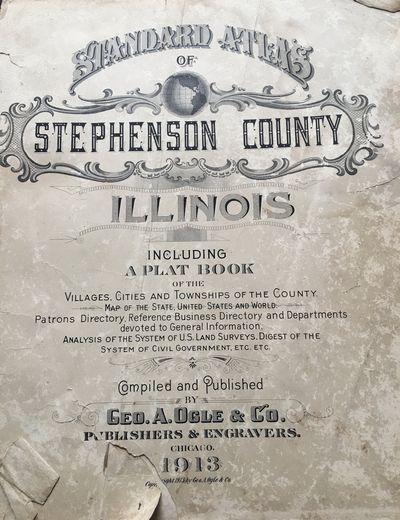
I inherited this book from my grandfather, Lloyd Bike who farmed 80 acres a couple of miles northwest of Cedarville in Buckeye Township. Copyrighted in 1913, it has long been in the public domain. There are hundreds of maps, plats, drawings and photos. I am including here many of interest to historians.
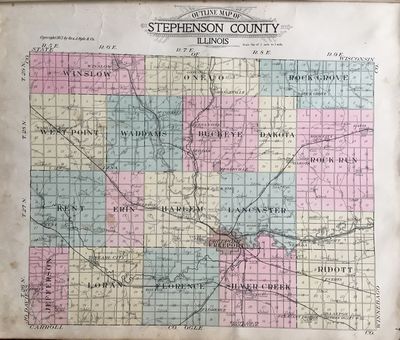
Stephenson County, Illinois, showing cities, towns, townships, rivers and roads in 1913.
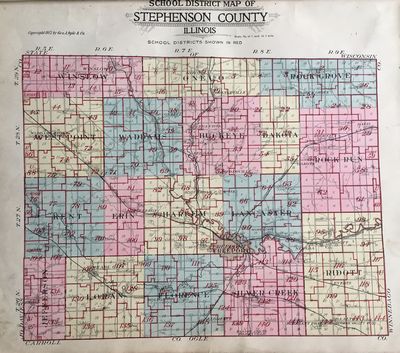
1913 School district map of Stephenson County, Illinois.
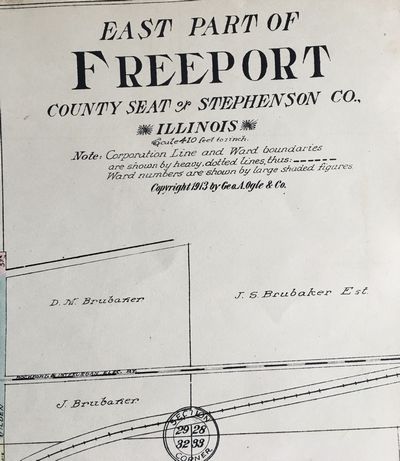
Close-up view.
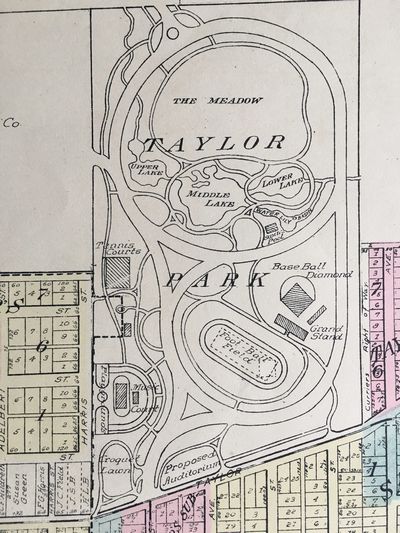
Taylor Park, showing The Meadow, Upper Lake, Middle Lake, Lower Lake, Water Lily Basin, Swim Pool, Tennis Courts, Base Ball Diamond, Grand Stand, Foot Ball Field, Play Grounds, Music Court, Croquet Lawn and location of Proposed Auditorium.
Northeast
Freeport in 1913
(click on photo to see an enlarged version)
-
Louise Street is now Park Street.
-
The school at the corner of Crocker and Wilber was East Freeport School, torn down when Taylor Park School was built.
-
Evans Street at the south ends of Sherman and Sheridan no longer exists.
-
Hancock Ave. south of the river used to be Gund.
-
Two roundhouses are shown: the larger Illinois Centraal RR, and the smaller Chicago and Northwestern RR. Roundhouses were used by the railroads to turn the engines around.
-
That part of East Stephenson Street was called Taylor Avenue.
-
The dashed line from left to right in the middle of the map was the Electric Railway, then it veered off Stephenson/Taylor onto Miles Street, and was known as the Rockford and Interurban Electric Railway.
Southeast
Freeport in 1913
(click on photo to see an enlarged version)
-
Columbus Avenue is now East Shawnee Street
-
First, Second, Third, Fourth, Fifth and Sixth Streets are now 13th, 14th, 15th, 16th, 17th, and 18th Avenues
-
Rail lines ran directly into The Arcade Manufacturing Company
-
St. Vincent's Orphanage Home is shown, but no Aquin High School, yet
-
There was a German Catholic Cemetery
-
Galena Avenue and Adams Street ran parallel to the ICRR
-
Rayhorn Street became an extension of East Wyandotte Street
-
Delaware Street became an extension of East Pleasant Street
-
Rotzler Lane became S. Rotzler Avenue, and extended south past Jefferson
-
Gardener's Lane became S. Armstrong Avenue
-
Elizabeth Street became S. Hyde Avenue
-
Vine Street became S. Miami Avenue
-
The Electric Railway came east on Empire, turned north on Bauscher, then returned downtown traveling northwest on Adams, north on Chippewa, east on Shawnee, then north on Gund/Hancock to Taylor/Stephenson.
North
Central Freeport in 1913
(click on photo to see an enlarged version)
-
The area in pink in the upper right was known as Kilgrubbin.
-
Streets shown include Henderson, First, Second, Third, Nora, Queen, Lancaster, McClurg, Allen and Goodhue.
-
Only Henderson, 3rd and McClurg still exist.
-
In the 1860s and beyond, this was a thriving part of Freeport, including grain dealers, merchandisers, and even a bank.
-
In about 1865, Jane Addams went to Kilgrubben for the first time with her father, and also for the first time, saw poor people and how poor people lived. She resolved at that early age that she would dedicate her life to helping the poor. She followed through, and in 1931 was awarded the Nobel Peace Prize.
-
Moving south along the railway tracks we can see another roundhouse, this one for the Chicago, Milwaukee and St. Paul Railroad.
-
Crossing the river on the railroad bridge, we see the carriage works on the left and the power station on the right. We can also see the dam on the Pecatonica River that supplied a flow of water to the power station. The dam was built in 1847 to supply water to Hanchett's sawmill. A flood in 1931 washed away the dam.
-
Keene Canning is shown on Monterey Street.
-
North of the Van Buren Street bridge used to be Cedarville Road, is now an extension of Van Buren Street.
-
Next is the Water Works. Despite it being next to the river, Freeport's water actually comes from deep artesian wells.
-
More street name changes: Fourth Avenue became an extension of Ringold.
-
Oak Place became Linden St.
-
Mechanic Street became State Street.
-
Williams Street became Iroquois Street.
-
There were two Galena Streets, and there was actually an intersection of the two Galena Streets! One of them became Main Street.
-
At the corner of Douglas and Powell there is a Bottling Works.
-
The Electric Railway connected Freeport east-west on Stephenson Street from Highland Park west of Globe/Park, to Taylor Park and on to Rockford. There was a terminal at Stephenson and Mechanic/State. A branch covered southeast Freeport south on Carroll, east on Empire, and returning downtown on Adams. Another branch covered northwest Freeport on West Galena Ave.
South
Central Freeport in 1913
(click on photo to see an enlarged version)
-
Just above the crease we see Freeport High School at the corner of Pleasant and Galena.
-
The Oscar Taylor estate is shown on S. Carroll Ave. His estate later became the Stephenson County Museum
-
At the bottom right we see the farm of George Finkbeiner, my great-great-grandfather. He owned rock quarries that much of the rock came from to build the old St. Francis Hospital and many of Freeport's magnificent old stone churches.
-
H. W. Knowlton owned the block where the current Freeport High School was built.
-
C. D. Knowlton owned the block where Freeport Junior High School was built.
-
D. A. Knowlton owned the block where Blackhawk Grade School was built.
-
The blocks west of the current High School were originally plotted to be a subdivision, but F. A. Read had other ideas, and now we have Read Park. The street running east-west through the park was to be called Calumet; now it's Park Lane Drive. Read Street became S. Prairie Ave.
-
North of the high school, Grand St. became Moseley St.
-
Fifth Avenue used to be between Elk and Homer; now it's called Avon St.
-
St. Francis Hospital is shown on S. Walnut Ave. I was born there, as were many of you.
-
Union St. School is shown on S. Union St. Now it's S. Chicago Ave., but it's still Union School.
-
Homeowners' names are shown on S. Maple, but nowhere else!
-
The subdivision west of the junior high school shows straight streets in 1913, but now Monroe curves and adds Monroe Court.
-
S. West Avenue is still the same, but West St. in the subdivision is now W. Jefferson. So there was the intersection of West and West!
-
The Electric Railway came south on Chicago, turned east on Williams/Iroquois, then turned south again on Carroll, and east on Empire.
Northwest
Freeport in 1913
(click on photo to see an enlarged version)
In the upper right we can see the Franz Bros Brewing Co, and just west of that, the Freeport City Stone Quarry, then the F. Trunck & Son Brick Yard. In pink above that is the Swan Piano and Organ Factory.
The north/south streets were First, Second, Third, Fourth, Fifth, and Sixth, and are now Prentice, Turner, Warren, Brewster, Hunt and Waddell.
South of Galena, the two east/west streets were both named Smith! The northernmost one changed to Langdon.
The Electric Railway came out W. Galena Ave. from downtown, all the way out to Sixth/Waddell.
Southwest
Freeport in 1913
(click on photo to see an enlarged version)
Just above the crease we see Harlem School, and just below the crease is the hospital.
The electric railway line runs all the way out to Highland Park, an amusement park that even had a roller coaster!
There were Public Play Grounds at the northeast corner of Logan and Stewart. Now it's all residential.
The Freeport Country Club is shown in the far southwest corner.
There were also a number of street name changes. Schofield Street became N. Stewart Ave. Van Brocklin became N. Sunset Ave. Hall Ave. became W. Hurd St. And Neese Street, which ran parallel to Hall/Hurd just to the south, is gone; now just houses.
Lincoln Avenue became Lincoln Boulevard. Globe Avenue became Park Boulevard, and the streets west of Globe/Park are quite different. Johnson Street became an extension of W. Harrison St. Rogers is still there, but the two streets west of Rogers, Goddard Ave. and Giddings Ave. are completely gone. The western 3/4 of Eby St. is covered by Carl Sandburg Middle School.
North of Empire off McKinley, Grant St. became W. Violet St., and Elizabeth St. became an extension of W. Pleasant St.
Shaffer St. became S. Harlem Ave., and Edward St. became Edwards St.
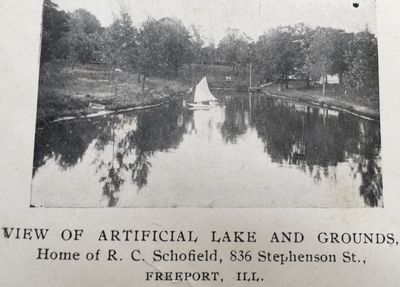
Schofield Lake in 1913
At the northeast corner of Stephenson and Schofield/Stewart was the property of Robert Schofield. It was covered with trees and at the bottom was a swampy area fed by a little stream. He built a dam at the bottom which created a small lake. He built a ramp down the hill, a "Shoot the Chute" that took the little boat down the ramp into the water. He had a building that sold tickets and refreshments.
(Not only have street names changed, but the numbering did, as well. 836 W. Stephenson in 1913 was far west of the current 836, which is the old Rawleigh home. This location is now 1422 W. Stephenson.)
In the same block was the Poling Zoo, which had possums, armadillos, ducks, deer, and a bear cub. Dr. J. A. Poling created a zoological garden which was there for six years.
Neighbors objected to both the Shoot the Chute and the zoo. The lake was leased to a private club, the Lakota Club, and the zoo was moved to Highland Park, and still later to Krape Park.
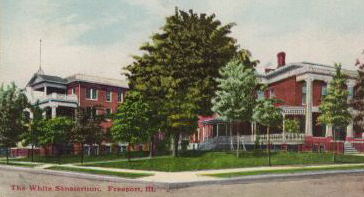
A postcard of White Sanitarium in 1913.
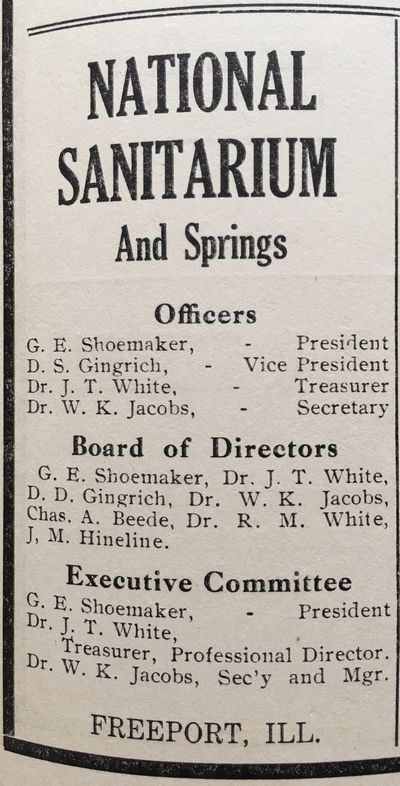
An advertisement in the 1913 Plat Book.
The White Sanitarium, or the National Sanitarium, was a private hospital in the former home of Freeport's mayor from 1895 to 1898, James Younger.
The White brothers, J. T. and Robert, operated it.
Winifred Taylor established the Christian Training School for Nurses.
In 1913 they opened Sanaport Springs (on the Plat map as White Sanitary Springs) for the "scientific treatment of rheumatism, plus mud baths, and hydrotherapeutic procedures." It immediately put both the sanitarium and the springs into financial difficulties.
The sanitarium was sold to Dr. J. H. Stealy who changed the name to Freeport General Hospital.
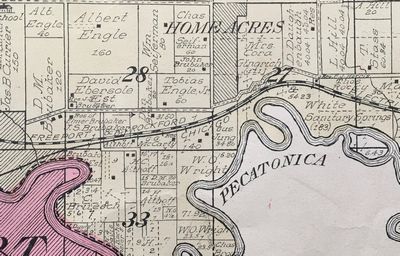
Northeast of Freeport in 1913
This little section of the plat book has a lot of Freeport history. In the upper right corner is the farm of A. J. Hill, a co-owner of the Union Dairy. His farm became the site of Hillcrest Airport, an important training field for pilots in the first half of the 20th century. One problem with the Hillcrest Airport is that it was built on rolling hills, not flat land. It was said that if you could fly out of Hillcrest, you could fly out of any airport!
The Interurban tracks ran east out of Freeport between River Road and the Pecatonica River. The first stop was the farm of William O. Wright, who allowed people to picnic on his land along the river, which people called Wright's Woods.
The second stop was Home Acres on the north side of the road, and to the south was Forest Park, a hiking and camping area. This was low timberland, lush with violets in the spring. Pulitzer Prize winning poet Carl Sandburg (1878-1967), in his poem "Localites," wrote about Freeport,
"On
the Pecatonica River near Freeport
I have seen boys run barefoot in the leaves
Throwing clubs at the walnut trees
In the yellow-and-gold of autumn,
And there was a brown mash dry on the inside of their hands."
The third stop was Sanaport Springs Farm. The spring water was advertised to be beneficial to health, and it was bottled and sold. There were therapeutic mud baths there, where you could soak in the luxurious healing mud of the Pecatonica River!
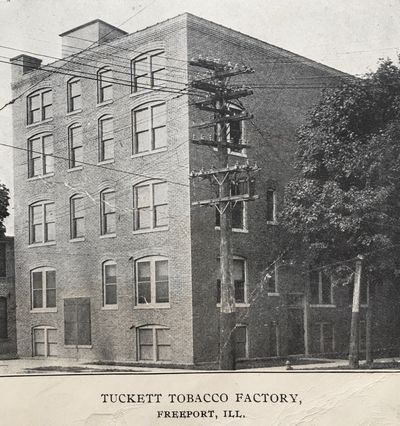
The Tuckett Tobacco Factory in 1913
J. E. Tuckett established a tobacco factory in Freeport in 1890. He brought to Freeport a black couple, the John Lipscombs. One of their sons, George Dewey Lipscomb (1898-1957), was the first black student to graduate from Freeport High School, in 1917. He was a brilliant young man, and a great orator, winning speech contests at FHS and Northwestern University.He taught at two colleges and at Howard University in Washington, D.C. He authored several books, and portrayed Frederick Douglass at historical events, much like Steven A. Cole does today. I wrote about him and his many accomplishments on the 1917 page.
The building is at the northwest corner of Chicago and Clark, and is now being used for apartments.
Downtown Freeport
in the 1913 Plat Book
(click on photo to see an enlarged version)
This photo has a lot going on. This is Stephenson Street looking east showing the intersection with Chicago Avenue.
The overhead banner reads, "Democratic Club - Wilson - Marshall - Dunne, with portraits of the three men, President Woodrow Wilson (1856-1924), Vice-President Thomas Marshall (1854-1925), and Illinois Governor Edward Dunne (1853-1937). Dunne is the only person to serve both as mayor of Chicago and governor of Illinois.
The electric railway tracks run down the middle of Stephenson Street, with a street car visible in the distance. There are two single-horse buckboard wagons, an early automobile, and men and women walking. There is a bicycle propped up against the curb on the left. Stephenson Street is either brick or wood blocks.
The first building on the left has two signs that I can read, DENTIST, and M J & C CLOTHING. The Smith building is under construction, with brick laid up to the fourth floor. I can make out the Little plate tower, the Brewster House Hotel, and the building that held Garrity's Drugs. There are some tall buildings in the distance that are probably the Schmich Brothers Brewery and Stover Engine Works. The only other thing I can make out is the wording on the awning at the far right, ICE CREAM.
Downtown Freeport
in the 1913 Plat Book
(click on photo to see an enlarged version)
This photo is looking west from Chicago Avenue. Once again we see the bricks on Stephenson Street, the electric railway tracks and railway car, several pedestrians, a few bicycles, and two automobiles.
The courthouse trees are visible on the right the next block up. Unfortunately, the quality of the photo is not good enough to make out business signs.
Main
Street looking West from State Street
In the 1913 Plat Book
(click on photo to see an enlarged version)
Another vintage photo of downtown Freeport with lots of detail. There are a lot of different types of horse-drawn vehicles and one motorized vehicle. Galena/Main appears to be brick. The signs on the left side say "NEW - DRY GOODS STORE" and "NEW YORK HOTEL." On the side of the largest building on the right is the word "BARGAIN" and something else indecipherable below. The architectural features on the buildings are unique, compared to many modern buildings.
Chicago
Street looking south from Stephenson Street
in the 1913 Plat Book
(click on photo to see an enlarged version)
Brick streets, electric railway tracks and railway car, pedestrians, some bicycles in the distance, horse drawn carriages, automobiles, and some street kiosks.
The buildings on the left say Dentist, Journal (the newspaper office), and on the right, Clothing, which was on the W. O. Wright store.
The corner store on the left with the clock was Edward Bengston, Jeweler and Optician!
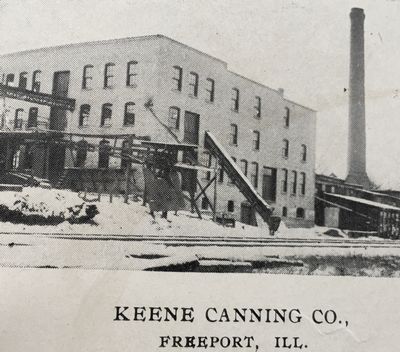 .
.
Keene
Canning Company
on E. Monterey St.
In 1913, Keene advertised that they canned corn, peas and pumpkins under the labels White Owl, Bicycle, Emblem, O. K., Our Country, and Nobility.
Early canning companies in Freeport were started by William Emery and J. D. Williams in 1886, and Fremont O. Keene and Mr. Diffenbaugh in 1887.
They merged and built the Keene Canning Company factory in 1888 at the site of Freeport's first cemetery. The bodies of both Winnebago and early white settlers had been dug up and moved to City Cemetery!
Keene Canning closed in 1953.
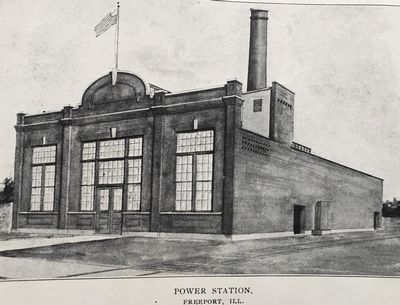
Power Station
Electricity was generated in Freeport until 1931, first using water power, then burning gas.
This is probably the Freeport General Electric Company building located on Manufacturers Island at the foot of Oak Place (now E. Linden St.) between the railroad tracks and the Pecatonica River.
The 1913 Plat Book shows a power station on Manufacturers Island, but the 1970 History of Stephenson County places it at the foot of Main Street.
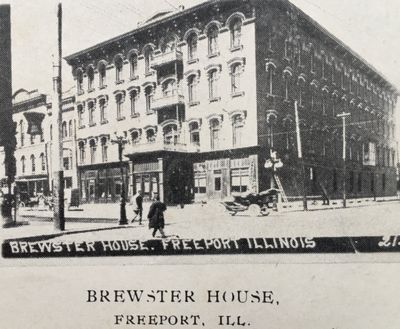
Brewster
House Hotel
northwest corner of Stephenson and State
Both Abraham Lincoln and Stephen Douglas stayed here in 1858 for the Lincoln-Douglas debate. Lincoln was assigned Room 56, on the third floor corner room visible in the front right. It was in this room, according to his followers, that Lincoln decided, against the advice of his advisors, to formulate his questions to Douglas to force him to make public statements on whether new states forming from territories should be slave or free. Douglas' answers split the Democratic Party. In the north, it was called the Freeport Doctrine; in the south it was called the Freeport Heresy.
Douglas and his followers were assigned rooms across from Lincoln, but Douglas stayed overnight at Postmaster Brawley's.
Both Lincoln and Douglas spoke to their followers from a second floor balcony, and they appeared together there. The balcony does not appear in this photo, as it was removed a few years later because overcrowding made it dangerous.
Douglas' first speech in Freeport was at the Brewster House. Lincoln was met at the train station and marched through a large throng of admirers to the Brewster House.
The Brewster House Hotel was the headquarters of both politicians, and they went from there a block north to the platform where the debate was held.
It is said that the Freeport debate on August 27, 1858, won the 1858 senate election for Douglas and the 1860 presidency for Lincoln. Read all about the debate on my 1858 page.
In 1856 John K. Brewster started construction of what was to be the finest hotel in Freeport. Four stories high, it had a 60-foot fronting on Stephenson Street, and 155 feet on Mechanic/State Street.
The ground floor had a store, a bank, and offices of C. H. Little and W. Hyde. The C. H. Little store was next door to the west of the hotel. The famous Little Plate Tower is visible in the photo.
A long straight stairway led from the front entrance to the second floor.
The second story had the hotel office, a circular bar, parlors, a dining room and kitchen.
The third and fourth floors had 51 bedrooms, of which nine had parlors attached.
The first guests of the hotel stayed on August 25, 1857, and were from Chicago, Buffalo, Rochester, Springfield Mass., Madison, Freeport, and many area towns.
Running water was installed in 1882, an elevator in 1886, and steam heat in 1889. In the years before running water was installed, water was obtained from a spring between the hotel and the river. Tin washpans hung on the walls. Heat came from 70 wood stoves. Light came from candles or sperm oil lanterns.
Besides Lincoln and Douglas, many famous people stayed at the Brewster House Hotel, including General U. S. Grant in 1862 when visiting General Shaeffer, General John Logan, General Benjamin Butler, Robert Lincoln, President William McKinley, William J. Bryan, John L. Sullivan, Senator Johnson, Robert Lafollette, Judge Kenesaw Mountain Landis, Senator Wilke of Ohio, General Len Small, Governor Mountain Grove Brumbaugh of Pennsylvania, Joseph Medill of the Chicago Tribune, President Theodore Roosevelt in 1903, Susan B. Anthony, and Ralph Waldo Emerson.
The Brewster House Hotel was torn down in 1932. Some of the timbers were saved and reused for a building in Read Park and a barn.
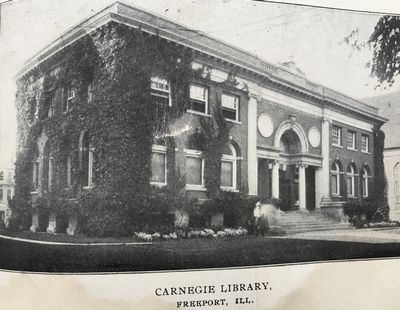
Carnegie
Library
W. Stephenson St.
In 1893, Andrew Carnegie, the famous philanthropist who became one of the world's richest people through building a steel business, gave Freeport $30,000 for the building on the condition that Freeport provide the site and operational funds. It was completed in 1902.
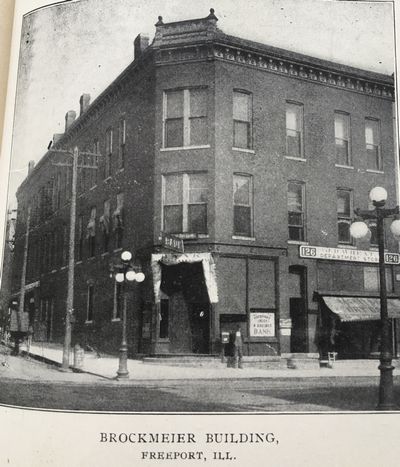
The Brockmeier Building in 1913
The business at the corner is Freeport Trust & Savings Bank. Above the bank sign is a small sign that says "... Dressing." The sign at the right says J. D. Wheat Department Store, and apparently the address, 126. This puts this building at the northeast corner of Van Buren and Main.
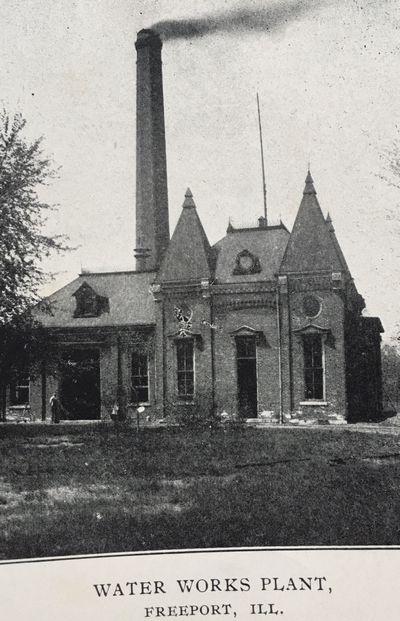
Water
Works Plant
North end of Brick Avenue
Built in 1882, this brick building held the water pumps. By 1883, 18 small artesian wells supplied Freeport its water.
The tall smokestack was for the steam engine that was used to pump water until 1939.
By 1964, there were five deep artesian wells, and electric pumps were used to move water into the tall water towers on S. Carroll Avenue and S. Burchard Avenue. The tall towers provide the water pressure naturally.
The Saint Peter Sandstone Aquifer is rather shallow, at about sea level, so the shallowest well is only about 700 feet deep. It generally follows the path of the Pecatonica and Rock River valleys, percolating water that slowly drips down from the rivers. Geologically speaking, the Saint Peter refreshes itself rather quickly.
Another well taps the Ironton-Galesburg Aquifer, which is much deeper, about 800 feet below sea level.
And a well taps the Cambrian-Trempealeau Aquifer, an ancient source of groundwater, which at its shallowest, is 1200 feet below sea level.
These are artesian wells, with water stored under pressure naturally. The water rises in the well to a level of hydrostatic equilibrium.
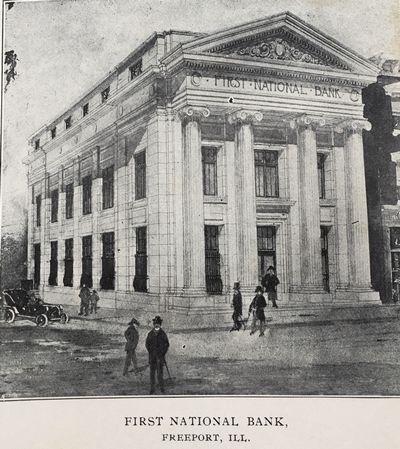
First
National Bank
on the southwest corner of Stephenson and Van Buren
Started in 1864, the First National Bank was remodeled to this building in 1910.
The four 27-foot pillars were added in 1912, in the Greek classical style, with each pillar cut from a single stone and weighing 15 tons!
This building was torn down in 1963.
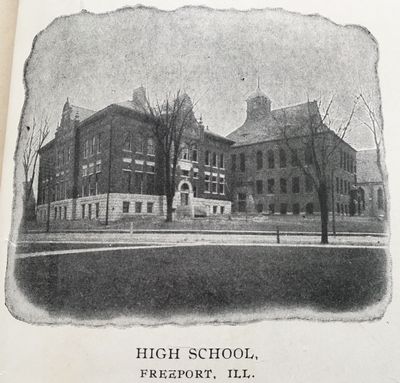
Freeport
High School
shown with the 1905 addition
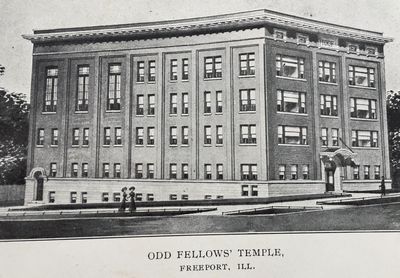
Odd
Fellows Temple
southwest corner of Main & Walnut
The Independent Order of Odd Fellows (IOOF) is a fraternal organization, non-political and non-sectarian, founded in 1819, "to visit the sick, relieve the distressed, bury the dead and educate the orphan."
This building was built in 1913 (hence the drawing rather than a photo) and had concerts and a bowling alley.
Jelly Roll Morton and his Red Hot Peppers played here on October 24, 1927!
My
father worked as a pinsetter in the bowling alley here in the late 1920s.
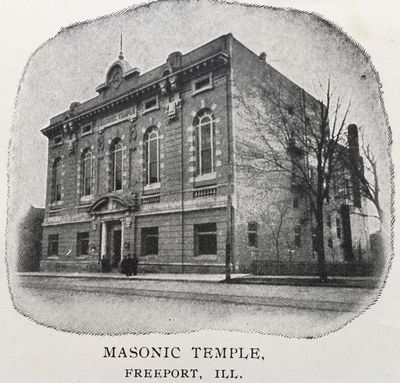
The
Masonic Temple in 1913
W. Stephenson between Walnut & Cherry
The Masonic organization chartered the Freeport Chapter in 1867. The building above was built in 1905 and razed in 1926. The newer, larger temple was built in 1928.
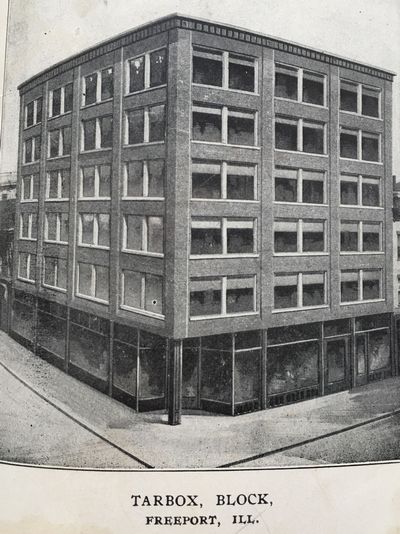
Tarbox
Block
shown under construction above in Stephenson St. looking east
became Smith Building
northeast corner Stephenson & Chicago
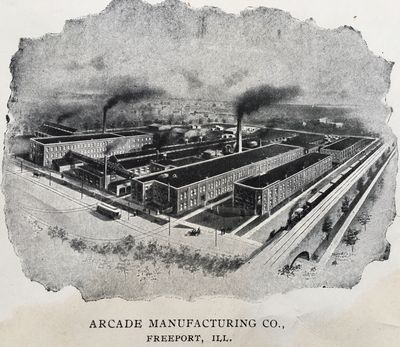
Arcade
Manufacturing Company in 1913
northeast corner Hancock & Shawnee
The Arcade Manufacturing Company was founded in 1885 and was a staple Freeport business until 1953. It was sold to Rockwell Manufacturing in Pittsburg, Pennsylvania, in 1945, and they gradually moved all divisions elsewhere.
Arcade was famous for coffee grinders, toys, hinges, cork extractors, and more. By the 1930s more than 300 different cast iron toy items were made there, including automobiles, banks, trains, fire engines, circus wagons, and the blue and white buses of the Chicago Century of Progress Exposition. During World War Two, the factory made war items.
My grandfather, Henry "Heine" Wienand, worked there for many years, and lived in the Arcade Addition east of the factory. My Uncle Bob Wienand also worked there until he volunteered for service during World War II.
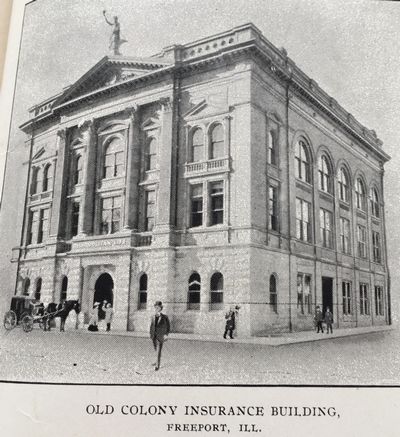
Old
Colony Insurance Building in 1913
southwest corner Galena & Exchange
note the statue on the roof
In 1861 the Winneshiek Insurance Company was founded by local investors and some well-known people, including Ulysses S. Grant. It prospered, and in 1865 they built a two-story building on this corner.
The business failed in 1871, and the German Insurance Company took over the building.
In 1897, German Insurance outgrew the old building, and erected this one, variously known as the German Insurance Building, the Old Colony Insurance Building, and the Cheeseman Building.
In 1906, German Insurance failed because of losses suffered in the San Francisco earthquake.
Next, Crum and Forster occupied this building until they outgrew it and built a new headquarters in 1929. Economy Insurance rented out the third floor of this building from 1915 to 1951.
The Freeport Journal Standard also operated out of this building for a number of years.
I don't know what happened to the statue on top of this building.
When the Stephenson County Courthouse dome was dismantled in 1927, the clock in the tower was stored in the basement of this building. I don't know if it is still there.
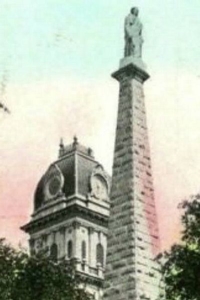 The
clock in the courthouse dome weighed 2000 pounds, and its pendulum was
8.5 feet long.
The
clock in the courthouse dome weighed 2000 pounds, and its pendulum was
8.5 feet long.
The clock was built by Seth Thomas & Sons, and had a 1,850 pound bell that struck the hours. In 1915, one of the 500-pound weights crashed through two floors of the courthouse.
The clock began to wear out, and in 1923 started acting erratically. Freeporters depended on the clock, and the erratic clock threw off everyone's schedules.
In 1927, it was declared unsafe, the clock was dismantled and the dome removed.
In 1934 a much smaller clock tower was installed. It was removed in 1965.
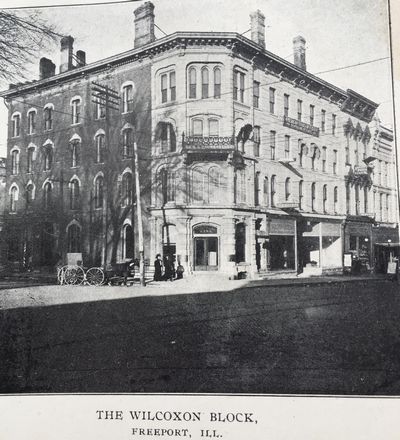
The
Wilcoxon Block in 1913
at the northeast corner of Stephenson and Van Buren
Built in about 1879 by Thompson Wilcoxon at the site of the Plymouth block, this building housed the Wilcoxon Opera House on the third floor. It was a popular venue for live shows, including, once, horses!
it had a frontage of 66 feet on Stephenson and 77 feet on Van Buren.
The building was designed by Dankmar Adler (1844-1900) of the Chicago School of Architecture. Adler was also an acoustic engineer, and designed buildings with excellent acoustics. Adler also designed the First Presbyterian Church and the Munn building. He was partners with Louis Sullivan, and together they designed some of America's most iconic buildings. For a while they employed a draftsman named Frank Lloyd Wright.
The federal government leased space in the building for Freeport's Post Office before the current post office building was built in 1905. The Herald newspaper composing and editorial rooms were in the basement. Initially the First National Bank was on the first floor, along with some stores. The second floor had offices. And the third and fourth floors held the Opera House Auditorium, a full 60' by 50', complete with a stage. The Opera House could hold 800 people!
Later, the Second National Bank was on the first floor. They remodeled the building in 1917, adding a fifth floor and an elevator. After 1917 it was known as the Second National Bank Building.
The building burned in one of Freeport's most spectacular fires in 1955. Hopkins Drug Store was on the corner, with Angelos Restaurant next to it on Stephenson, and upstairs many doctors and dentists offices were lost. I remember standing on the Court House lawn with my parents and hundreds of others watching the Freeport Fire Department try to put out the fire.
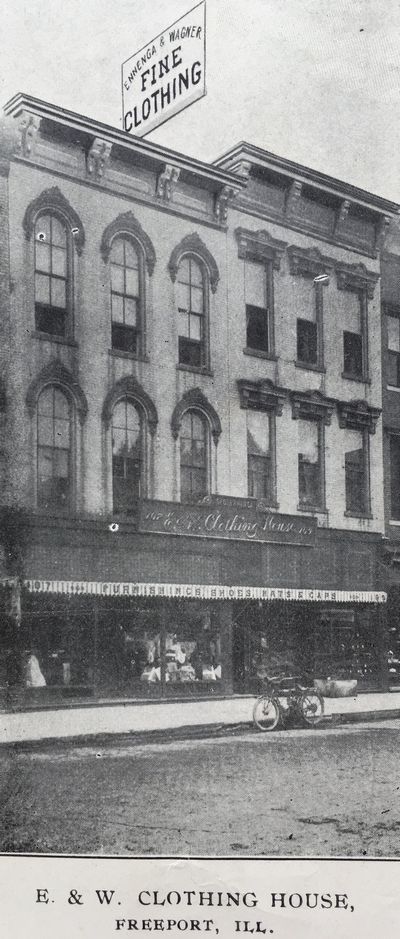
E
& W Clothing House in 1913
south side of Main Street between Galena & Walnut
note the motorcycle out front
In 1889 George Ennenga and his father-in-law Fred Wagner started this clothing store. The awning states: FURNISHINGS SHOES HATS & CAPS.
The Ennenga family ran the store for 101 years, and expanded with stores in Rockford in 1894, Sterling in 1897, then Springfield, Galena, Lena, Polo; Sioux City, Des Moines and Davenport, Iowa; and Platteville and Shullsburg, Wisconsin.
Fire destroyed the Freeport store on January 7, 1957. The fire started in Stukenberg's ladies fashion store in the building just to the west, progressed through E & W, and moved into Leath Furniture on the Galena corner of Main. (I remember my father coming home and telling us that there was a big fire downtown. We piled into the car and went downtown to watch the big fire.)
E & W reopened in a few days at the southeast corner of Main & Van Buren with a well-attended fire sale.
E & W closed it doors for the final time in 1990 after 101 years in business.
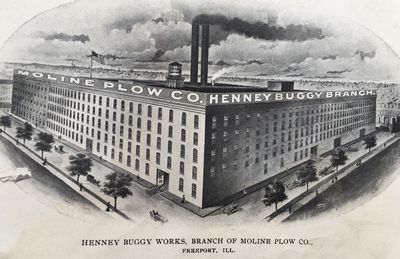
Moline
Plow Company
Henney Buggy Branch in 1913
Jacob Henney started a wagon shop in Cedarville. His son John W. Henney and his grandson John W. Henney, Jr., grew the business. John W. added buggies to the wagons in 1868. His first customer was John H. Addams, father of Jane Addams.
In 1878, the Henneys moved the factory to Freeport, and began erecting the five-story block-square Henny Building south of Spring between Chicago and Van Buren, completing the factory in 1888. The building now houses Micro Switch.
They manufactured phaetons (a light open carriage pulled by a pair of horses), spring wagons (a general purpose box wagon usually pulled by draft horses), sulkies (a two-wheeled vehicle drawn by one horse), buggies (a four-wheel one-horse carriage), and a tourist wagon (a larger wagon with multiple seats pulled by multiple horses). Eventually, Henney also made many more styles of buggies and carriages, all noted for their superior ride.
They sold vehicles around the world.
In 1903, Moline Plow Company bought the business and retained the Henney name. In 1908 Moline Plow bought the Robinson factory on Manufacturer's Island and built a five-story factory (that was later the home of Burgess Battery) to supplement production.
By 1910, 700 workers were producing 30,000 vehicles a month! That's 1000 vehicles per day, comparable to a modern car factory. Both factories had railroad spurs running into the building to enhance movement of raw materials and finished vehicle shipments.
When internal combustion vehicles were widely replacing horse-drawn vehicles in 1919, John N. Willys gained control of Moline Plow and closed this factory, keeping the second Freeport factory open to produce the Stephens automobile until 1924.
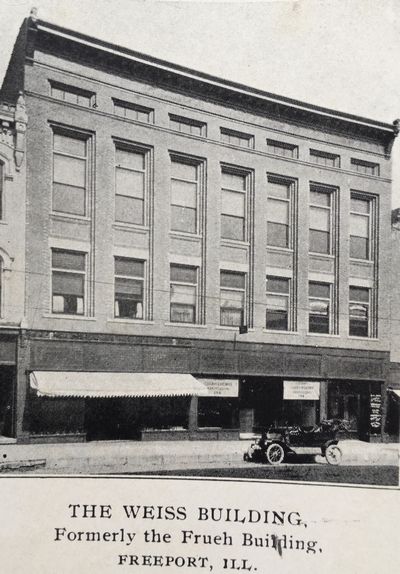
The
Weiss Building in 1913
Formerly the Frueh Building
208 W. Stephenson St.
on the north side of Stephenson between Galena & Walnut
Located just a half-block west of the courthouse, this building has long been attorneys' offices.
I'm a bit curious whether the third floor is extra high with an extra row of windows, or if the fourth floor has windows at knee level!
The third floor is taller than the other two floors. There is a stage at the rear, and at one time housed the JERC. The roof's pitch is so large that the windows let light into the attic.
Alfred Frueh built the building at the site of the Cyrus Sheetz store. Sheetz was a harness maker and pioneer businessman. The original building was both his harness shop and his home.
There's a tragic aside to the story about the Weiss-Frueh building. Alfred Frueh had a nephew, Clarence, born 1896.
Clarence Frueh was a Freeport police officer, a motorcycle patrolman. In the early morning of Friday, June 29, 1923, he apprehended a suspect at the Illinois Central train station and he took the suspect to the police station.
At the police station, they searched the suspect and found bullets in his pocket. He said that he had hidden the gun and offered to take the policeman to where he had hidden it.
So Patrolman Frueh put him into the motorcycle sidecar and took him to the corner of Lincoln and Pine. At this point, the suspect pulled out out a .25 revolver he had hidden in his clothes and shot Patrolman Frueh in the face, killing him instantly.
The suspect then fled on Patrolman Frueh's motorcycle, lost control at the corner of Locust and Lincoln, hit a curb, and broke his neck in the accident, killing him also.
The suspect was believed to be Tony Massud, a member of the "Cuckoo" gang who had killed St. Louis Police Officer Edward Griffin and merchant John Surgant on June 10, 1923, during a robbery attempt. Every part of the description matched, including a photo of Massud and the autopsy photo.
When the fingerprints of Massud arrived from St. Louis, they did not match. Eventually the suspect's body was buried in the pauper section of City Cemetery, still unknown.
Clarence Frueh was just 27 years old. He is the only Freeport police officer killed in the line of duty.
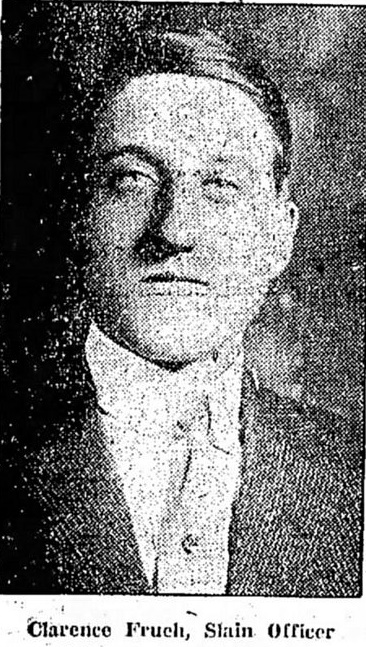

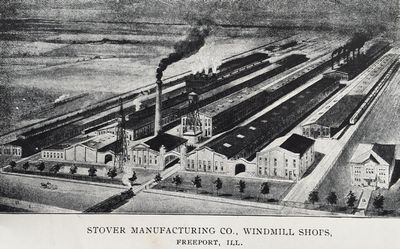
Stover
Manufacturing Company in 1913
Windmill Shops
on N. Henderson Rd.
In 1860 Daniel C. Stover began manufacturing windmills in Freeport in a building on the southeast corner of Stephenson and Cherry. At the time it was called the D. C. Stover Experimental Works.
By 1880, the business had outgrown its location and they bought the old F. S. Taggart Carriage shop. They incorporated then as Stover Manufacturing Company.
They expanded sales internationally and quickly outgrew this location, as well. Stover then bought the land east of the river and south of Stephenson Street and erected buildings for his Stover Engine Works.
In 1890, Stover purchased 45 acres on Henderson Road and built the complex shown above.
The two most well-known products they built here were the Sampson Windmill and the Ideal Feed Mill. The windmills were used both to pump water and to mill grain.
The complex included the manufacturing plants, a foundry, a machine shop, a power plant, a chemical laboratory, and offices.
A workforce of 400 manufactured 40,000 windmills a year until they closed in 1942.
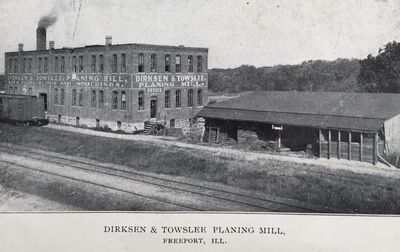
Dirksen & Towslee Planing Mill in 1913
The Dirksen and Towslee Planing Mill was founded in 1902 by Richard D. Dirksen and F. H. Towslee, and first began doing business in a small way in a factory on State near Main. When they outgrew this building they bought the factory formerly used by the Burrell Brothers Vinegar Works, and there established their new plant.
The factory was a three-story brick structure 40x100 feet, with adjoining lumber sheds which had a capacity of three hundred thousand feet of lumber, and two large moulding sheds, each 20 x 60 feet. The yards and mill covered two acres, and the Illinois Central had a siding for transporting raw material and finished goods.
They made all sizes of lumber, millwork, trim, and moulding for construction.
The Dirksen and Towslee property was situated just north of the railroad tracks and just west of West Avenue, Rt. 26, near the river, west of the Freeport Water Company buildings, and a short distance east of the D. E. Swan Organ Factory.
They employed 15 workers. The business done by the Dirksen and Towslee mill was mostly local although some shipping was done to the small towns within a radius of fifteen or twenty miles.
The Dirksen was a prominent Freeport family for a century. Gerritt Dirksen came to Stephenson County in 1844 and farmed in the Ridott area. He and his wife Antje had a store on State near Main. He had learned silversmithing in Germany, and set up a small work area in the back of the store where he could make silverware and filigree. By 1890, the silver was outselling the groceries, so they closed the store, hired some workers, and produced outstanding silver. Many of his pieces are in the Stephenson County Museum.
His son, Richard D. worked in the shop, supervised the workers, and led a large marketing effort. After Gerritt died in 1903, Richard closed the silver shop and opened a carpenter shop. As this business grew, he and Towslee opened the plant shown above. His son Richard Watson Dirksen built organs, his grandson Richard Wayne Dirksen was a famous organist and composer at the Washington Cathedral in Washington, D.C., and his granddaughter was organist at the church where I grew up, St. John UCC.
-
Gerritt Dirksen 1817-1902, silversmith
-
Richard Dietrich Dirksen 1854-1920, builder
-
Richard Watson Dirksen 1897-1976, organ builder, founder Freeport Organ Company, located in the shop behind the family home at 225 W. Cleveland St.
-
Richard Wayne Dirksen 1921-2003, organist, FHS Class of 1938
-
Phyllis Dirksen 1927-2010, organist, FHS Class of 1945
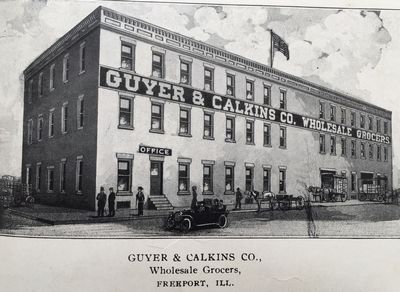
Guyer
& Calkins Company in 1913
Wholesale Grocers
Guyer & Calkins was a pioneer wholesale grocer from 1901 to 1966. The office & warehouse was in the 200 block of E. Spring St.
John Guyer, his son Ray Guyer and W. L. Calkins ran the company in the early days.
They sold in bulk to the dozens of small grocery stores in Stephenson County.
The Guyer & Calkins building was originally built by Pels Manny for manufacturing the Manny reaper, used to harvest grain. It was the first Freeport factory building.
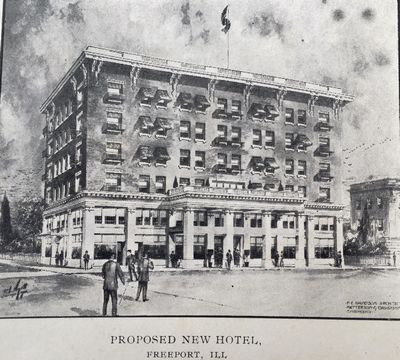
Proposed New Hotel
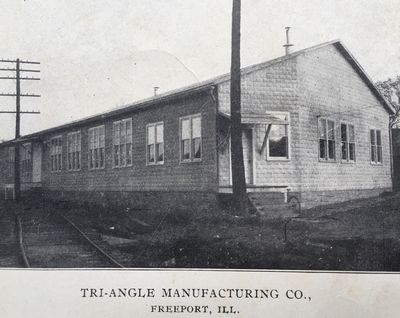
Tri-Angle
Manufacturing Company
location guessed at below
Harry Angle, a 1905 graduate of Freeport High school, is listed as a manufacturer in the 1910 History of Stephenson County.
In 1909, M. Redlinger and Harry Angle were selling a foot-powered grinder.
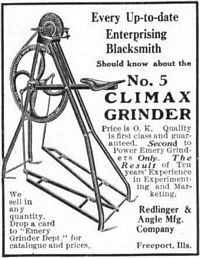
And by 1913, M. Redlinger was gone and it became Tri-Angle Manufacturing Company.
I have not been able to find the location of this building. It does have a rail siding to the building, so that narrows it down a little.
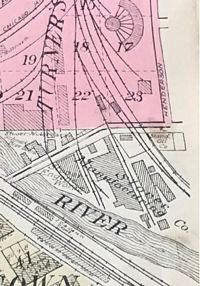
Freeport historian Leslie Fargher (1876-1979) reported that the Redlinger brothers ran a bicycle shop near the Schmich Brewery. In 1909, Redlinger & Angle were selling machinery that they were making, and the 1913 photo shows Tri-Angle Manufacturing. So I'm going to make an educated guess that the building shown above in pink just to the right of the "22" was both the Redlinger's bicycle shop and Tri-Angle Manufacturing. I'm guessing that the Tri part of the name was for the three men, the Redlinger brothers (probably Michael and Matt or Joseph) and Harry Angle, and the Angle part for Harry, plus a clever play on words.
Matt Redlinger (1869-1941) is buried in Freeport. Joseph Redlinger (1875-1957) is buried in Florida. Michael Redlinger (died 1935) is buried in Portland, Oregon. Jackson Harry Angle (1886-1969) graduated FHS 1905, studied engineering at UW-Madison, married Iva Iler (1883-1969) in 1907, moved to Oklahoma in the early 1910s, had two daughters who had successful careers, Betty (1918-2018) and Shirley (1924-1990), and was married for 62 years!

St. Vincent's Orphanage
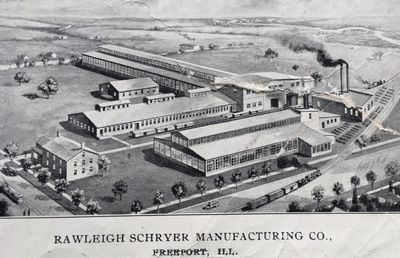
Rawleigh
Schryer Manufacturing Company
on a 6-acre tract on Taylor Avenue
Oscar Ziegler (1856-19xx) and Paul Schryer (1872-1931) started the the Freeport Gas Engine and Windmill Company, and a few months later incorporated as the Ziegler-Schryer Manufacturing Company in 1909.
They built engines that ran on gas, gasoline, and distillates. They also did machine shop work and made gray iron castings.
The company grew quickly and had 80 employees. They sought investors to expand, and W.T. Rawleigh invested in 1911. In 1912, it became Rawleigh Schryer. And in 1916, it became Rawleigh Manufacturing Company.
Ziegler learned to be a machinist under Charles Knecht in Freeport. He then went to Dekalb and learned how to machine barbed wire. After a few years he returned to Freeport to work for Daniel Stover and in 1880 was made Superintendant of Stover Manufacturing Company. In 1886 he married Hattie Snyder, daughter of J. H. Snyder. Oscar and Hattie made their home on S. Carroll Avenue.
Schryer was the genius behind the company. In 1884 he assisted in the design of the very first internal combustion gasoline engine. He also assisted in the design of many of the popular gasoline engines, including those made by Stover. Schryer designed fuel systems, fuel pumps, the ignition system and the exhaust valve. Ziegler and Schryer worked together at Stover until Daniel Stover died in 1908.
The buildings were designed to be fire proof, using the most modern concrete fabrications. There was a machine shop, a foundry and rail sidings.
The engines they built were based on a five-point superiority plan: simplicity, surplus power, ease of operation, balance and reliability.
The engines were from 1 to 25 horsepower, and were massive. The 2HP engine had 27-inch flywheels and weighed 630 pounds. The 25HP engine weighed 5800 pounds.
These engines were built to last. Engines in the hands of collectors still run flawlessly.
On January 12, 1917, the factory burned. It was a very cold January night, and the snow was deep on the ground, both factors making fighting the fires very difficult.
The night watchman sounded the fire alarm at 11:20 pm, and when firefighters arrived one end of one of the two large buildings was ablaze. They called the main station and asked for more hose, men and equipment.
At 12:05 am on January 13, just 45 minutes after the call came in about the Rawleigh fire, another major blaze was reported just a couple of blocks away at the Illinois Central Freight House, and the firefighters had to remove some men and equipment from the Rawleigh fire to fight the Illinois Central fire.
The fire at Illinois Central Freight was another major blaze. Believed to have started in the boiler room, it quickly destroyed the freight house, spread through a chute to the W. T. Rawleigh Medical Company, and also spread to the Northwestern RR Freight Depot. The Illinois Central lost all the records of the I.C. Wisconsin Division. Most of the medical company and Northwestern was saved.
The fire at Rawleigh Manufacturing completely enveloped the first large building, jumped to the second large building and destroyed it, and jumped again to the third, smaller building, and caused major damage. Fire officials later believed the fire started in the paint room.
Rawleigh Manufacturing lost all their written records and most of their machinery. Rawleigh never made another gas engine.
A factory complex as large as is shown above should be obvious, but it did not show up in the Plat maps because it is the complex that W.T. Rawleigh planned to build on Henderson Road.
Rawleigh saw the potential in the Ziegler-Schryer company, and wanted it. They were looking for minority investors, but he wanted control. First, he bought out Ziegler in 1912. Ziegler was already 56 years old and ready to retire.
Then Rawleigh did some legal and financial maneuvering to gain control of the company.
Schryer sold his shares and left the company in 1916 to become a vice-president at International Harvester in Milwaukee.
When the factory burned in 1917, Rawleigh lost interest. The buildings that burned were on the south side of Stephenson Street, behind the Standard Oil complex, on land that Rawleigh owned.
s
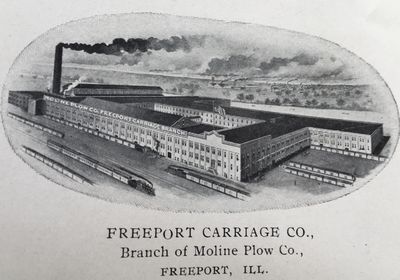
Freeport
Carriage Company
Branch of Moline Plow Company
Manufacturers Island
When Moline Plow bought out Henney in 1903, they built up the plant on Spring Street. By 1908, they filled that plant, needed more space, and bought the J. L. Robinson plant on Manufacturers Island. Robinson started his wagon and buggy manufacturing business in Ridott in 1873, and as his business quickly grew, he built a factory on Manufacturers Island in 1876.
Moline Plow/Henney built up this plant to five stories to supplement production. When John Willys gained control of Moline Plow in 1919, he used this factory to produce the Stephens automobile until 1924.
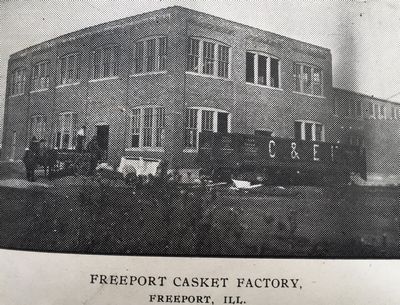
Freeport
Casket Factory in 1913
on E. Jackson near S. Louis Avenue
Fulwider's 1910 History of Stephenson County states, "The latest acquisition to the roll of factories and manufacturing plants has been the Freeport Casket Co. The Commercial Association aided the gentlemen interested in the organization of this concern to obtain a factory site on Jackson street in East Freeport. The plant will be immediately erected, and will soon be one of the most prosperous of Freeport's mercantile establishments."
Instead of erecting a new factory building, they used the old Henney Hearse factory building on E. Jackson near S. Louis Avenue. The Lena Casket Company later used the same building.
The 1970 History of Stephenson County (published in 1972) does not mention the casket company.
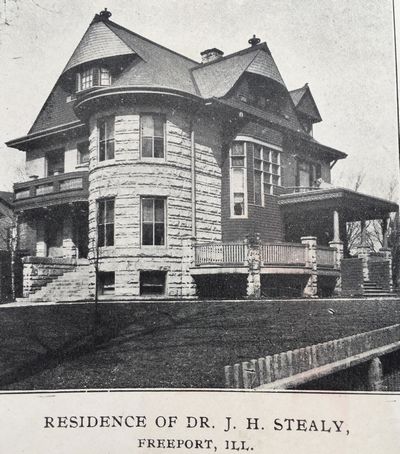
Residence
of Dr. J. H. Stealy in 1913
440 W. Stephenson St.
This magnificent house is still standing on the north side of Stephenson Street just as the street curves out of downtown.
Dr. Jeremiah Stealy (1859-1921) was a Freeport physician. He was one of the first physicians to practice at the new St. Francis Hospital in 1890.
In 1893, when Freeport was in need of an ambulance, the Henney Buggy Company donated an ambulance wagon, and Dr. Stealy provided the horse to pull the ambulance!
When the Drs. J. T. and Robert White (who owned White Sanitarium) got into financial difficulty in 1913, Dr. Stealy bought the operation and renamed it Freeport General Hospital.
He began his study of medicine at the University of Michigan in 1879. In 1882, he studied at the Jefferson Medical College, and in 1888 at the Polyclinic School of Medicine in New York. He studied medicine and surgery at the Medical and Surgical Hospital in Berlin, Germany.
Dr. Stealy began his practice in Browntown, Wisconsin, and came to Freeport in 1889 to go into partnership with Dr. W. S. Caldwell.
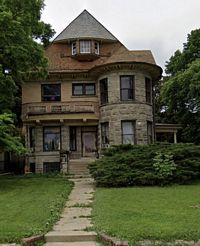
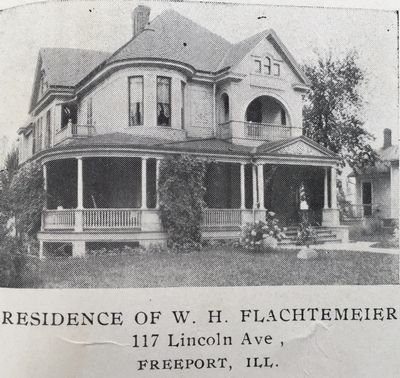
Residence
of W. H. Flachtemeier in 1913
751 W. Lincoln Blvd., built in 1892
Frederick Flachtmeier (1851-1893) arrived in the U.S. in 1867 from Prussia at age 16. He had started to learn the stone cutting trade at age 12. He found work in Freeport with Herman Nott, who taught Frederick how to cut stone and operate a business.
Frederick opened Freeport Marble and Stone Works on Galena in 1874. In 1884, he brought his brother, William Henry Flachtmeier (1857-1927), into the business with him, and they called it Flachtemeier Bros. Monument works. They relocated the business to Stephenson St. in 1886. Frederick and his wife, Wilhelmina Wittbecker Flachtemeier (1854-1948) have a nice (but unpretentious) stone in City Cemetery.
This was the home of W. H. and his wife, Henrietta Brinkman Flachtmeier (1860-1929). They have very simple stones in Oakland Cemetery.
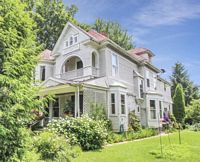
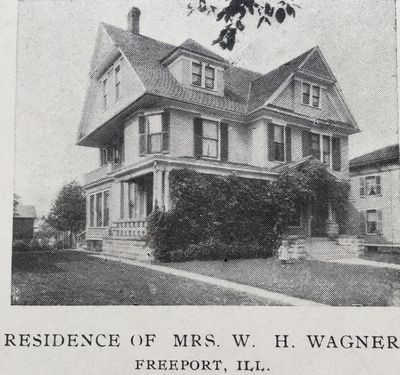
Residence
of Mrs. W. H. Wagner in 1913
806 S. Carroll Avenue, built in 1892
The baby standing in front would be about 110 years old now!
The Wagner family owned an early Freeport newspaper (the Deutscher Anzeiger), were investors in insurance (the German Insurance Company), and owned Wagner printing.
Wilhelm (William) Wagner, Sr. (1803-1877) owned and edited the German language newspaper. He was born in Germany, came to Freeport in 1852, and established the newspaper in 1853.
His son, Wilhelm (William) H. Wagner (1841-1910) assumed editorial duties in 1863. He married Wilhelmina Seyfarth (1839-1922). They had seven sons.
William Wagner owned and ran Wagner & Sons Printing, and ownership continued in the family for many generations.
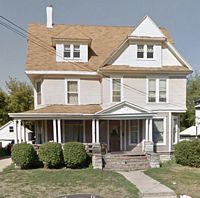
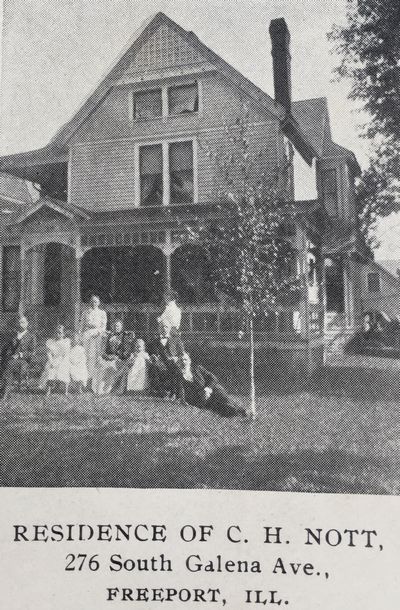
Residence
of C. H. Nott in 1913
now 942 S. Galena Ave., built in 1892
S. C. Herman Nott (1857-1938) was a third-generation monument maker. His grandfather, Henry Nott, came from Germany in 1853 and established the Nott Monument Works. He was followed by his son, Herman, then his grandson, C. H., shown with his family here.
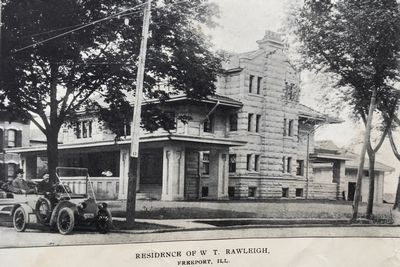
Residence
of W. T. Rawleigh in 1913
836 W. Stephenson St., built in 1907
W. T. is shown with his driver at left
William Thomas Rawleigh (1870-1951) was a Freeport industrialist, entrepreneur, mayor of Freeport (1909-1911), member of the Illinois House of Representatives (1911-1912) and at one time, was considered as a candidate for President of the United States.
He was a major art collector, and the remainder of his collection forms the basis of the Freeport Art Museum.
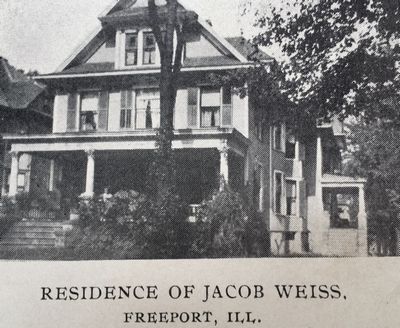
Residence
of Jacob and Sophia Weiss in 1913
704 W. Stephenson St.
built in 1897, this huge house is still standing
on the northwest corner of Stephenson and Grove
Jacob Weiss (1863-1941) was a prominent Freeport businessman. He was a director and vice president of the State Bank of Freeport.
He was a director of the Farm Mortgage Company. He was a director and secretary of the Northwest Telephone Company, and on the board of directors of the Shoemaker Automobile Company. He was president and director of the Freeport Building & Loan, and active in their business. He was a director of the Guyer & Calkins Company. He was an official of the Inter-City Box & Paper Company.
Jacob Weiss was a founding member of the Freeport Park Board and served several terms as president.
He was very active in non-profit activities, social organizations, and took the lead in getting Theodore Roosevelt to Freeport in 1903 for the dedication of the Lincoln-Douglas monument.
I wrote previously about the Weiss-Frueh building on W. Stephenson St.; Jacob Weiss bought the building from Alfred Frueh.
Jacob Weiss died of injuries six weeks after walking into the side of a moving stock truck near his home. Sophia Schrenkler Weiss(1862-1944) survived him.
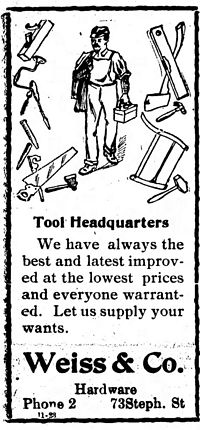
He was born in Schwetzingen, Germany, and came to Freeport in 1881. Initially employed by Bartlett Hardware, he started the Weiss Hardware Company at 73 E. Stephenson St. in 1896, a firm he and his son Otto Weiss (1888-1942) sold in 1925 to Steffen & Hepner.
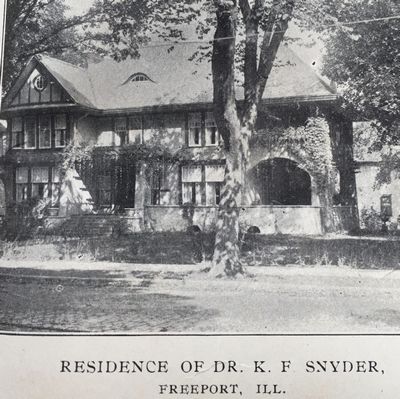
residence
of Dr. Karl & Alice Snyder in 1913
608 W. Stephenson St.
now the Elks Lodge
Dr. Karl Forbes Snyder (1876-1933) was a well-known physician and surgeon in Freeport for many years. He attended many births and many deaths.
An 1893 graduate of Freeport High School, Dr. Snyder earned his undergraduate degree from Northwestern University and his medical degree from the University of Illinois. He began his practice in Freeport in the office of Dr. Stealy.
Karl's father, Professor C. C. Snyder was Superintendent of Schools in Freeport for 18 years, 1872-1890; and from 1872-1874 was also Principal of Freeport High School.
Dr. Snyder bought an automobile in 1906, a gasoline-powered Holsman. Horse-less carriages were still rare then, running on steam, electric or gasoline. In fact, in 1906 there were only 100 automobiles in all of Rockford, and about 50 in Freeport.
Dr. Snyder was instrumental in getting Highway 26 paved between Freeport and Dixon in 1922, and between Freeport and the Wisconsin State line in 1923. He led the local effort to get the AYP built through Freeport in 1923. The AYP -— Atlantic-Yellowstone-Pacific was one of the first paved coast-to-coast highways, from New York on the east coast to Portland, Oregon, on the west coast, in conjunction with the park service to promote tourism.
In 1923 Dr. Snyder upgraded to a Lincoln Roadster. He had been partial to Packards, but liked his new Lincoln.
Dr. and Mrs. Alice Coleman Snyder (1881-1962) were both aviation enthusiasts. They both were passengers on July 1, 1927, aboard the first round-trip flight from Chicago to San Francisco aboard Boeing Airways, the predecessor to United Airlines. At the time of this flight, both the pilots and passengers wore parachutes. On the return trip, the plane was lost in fog for several hours over Omaha, Nebraska, with the flight taking 55 hours! Boeing had won the contract for air mail from Chicago to San Francisco. The plane was a Boeing Model 40A, a single-engine biplane that had a pilot in an open-air cockpit and a tiny cabin that held two passengers and mail.
Dr. and Mrs. Snyder bought their own airplane in 1931, a Consolidated biplane. Once they flew between Freeport and Rochester, Minnesota, a distance of 275 miles, in only one hour and twenty minutes, a trip that would have taken eight hours by automobile or an overnight trip by train. They bought the biplane to shorten his business trips to the Mayo Clinic in Rochester, The Cleveland Clinic, a St. Louis hospital, and other medical locations.
He later upgraded to a four-passenger Waco cabin plane. He had a hangar erected on a small field he owned about four miles east of Freeport on U.S. 20. The Hi-Lo Lounge and Supper Club built on the field, and it quickly became the "Hi-Lo Aviation Club."

La Hacienda
Dr. Snyder also owned a farm off of Pearl City Road, and another home adjacent to Krape Park he originally called Assinink Lodge, then later called La Hacienda, on 14 acres at the corner of Demeter Drive and Park Boulevard.
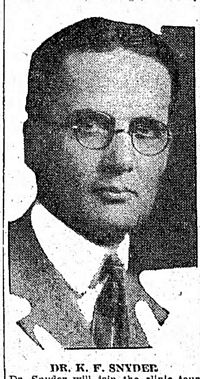
Dr. Snyder in 1921
In 1926 he put this house at Stephenson and Green up for sale, to live at his country lodge. It was bought by the Elks Club, who extensively remodeled and moved there in 1929. The Snyders also owned a home in Bradenton, Florida, and often wintered there.
He was a director of the Farm Mortgage Company. He was chief of staff at Deaconess Hospital and was instrumental in the hospital's expansion. He was active with the Consistory, the B.P.O.E., and served several terms as president of the Freeport Country Club.
On January 5, 1932, he and his nurse were driving home from Monroe when he lost control of his automobile just north of Oneco and crashed into a culvert. Dr. Snyder was thrown from the vehicle and his nurse was pinned under it. Dr. Snyder suffered numerous broken bones and internal injuries.
On November 28, 1933, despondent over continued ill health following his near fatal accident, Dr. Snyder walked downstairs into the basement of his home on Demeter Drive and fired a revolver shot into the base of his brain, killing himself instantly. He left signed notes apologizing and explaining why.

Alice stayed active in Freeport. She organized a snack bar in 1944 at the Illinois Central depot, and served free food to an average of two troop trains every day. My mother, Anna (Wienand) Bike, volunteered there after working shifts at Burgess Battery. By Christmas eve 1945, 239,000 troops had been served. Local individuals and businesses donated sandwich ingredients, cookies and drinks.
Alice Snyder was a well-known interior decorator. She was a founding member of the Stephenson County Humane Society in 1953. And for many years, Alice helped with set decoration for the Winneshiek Playhouse.
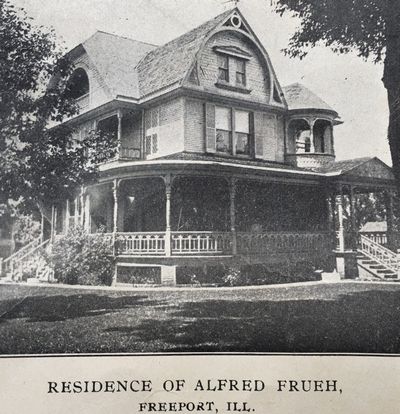
residence
of Alfred Frueh, 1254 S. Carroll Ave.
located at the northwest corner of Carroll & Empire
Alfred Frueh (1853-1940) was long active in the insurance business.
He was born in Monroe, Wisconsin, and his family moved to Freeport in 1854. He was hired at German Insurance in 1873, and worked his way up in the company to cashier, staying with them until they went out of business.
He then started an insurance agency with W. C. Steffen, Frueh & Steffen. He invested in real estate, in the Arcade and downtown. He was on the Board of Directors at Stephenson County Bank. He built the Frueh Building downtown, later called the Weiss Building, located at 208 W. Stephenson St.
Alfred was the uncle of Clarence Frueh, the only Freeport police officer killed in the line of duty.
Alfred
married Louisa Raubenheimer in 1880; she died in 1893. They had two
daughters, Alice Frueh Cavanaugh (1881-1942) and Edna Frueh (1885-1953).
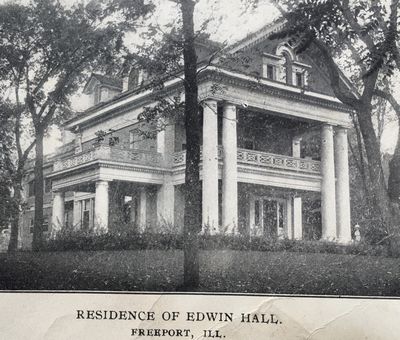
residence
of Edwin Hall
927 W. Stephenson St.
this house had a ballroom on the third floor
Edwin Hall (1856-1938) owned and operated William Walton Nephews dry goods store. He was also a director of the Security Trust Company.
Edwin married Laura Lydia Malburn (1869-1956). They had one son, Edwin Malburn Hall (1909-1995), FHS Class of 1926. Edwin became a teacher, and spent most of his career at the Naval Academy in Annapolis, Maryland.
William Walton was a pioneer settler in Freeport and opened a store at 104 Stephenson St. in 1858. It grew through the years, and in about 1874 he needed help running it, so he wrote to his three nephews in England and requested that they move to Freeport to help him. The three brothers did, with William (1854-1923) taking over the clothing department while Edwin took the dry goods department. Joseph (1855-1912) helped overall.
When William Walton died in 1898, he asked his three nephews in his will to change the name of the store to William Walton Nephews. They grew the store, taking over buildings next to it on both sides. Edwin outlived his brothers and operated the business until February of 1934. By the time of his death, Edwin owned considerable real estate in Freeport.
The house has seven bedrooms and three baths. The library has a fireplace; the dining room has a built-in buffet and fireplace; and the living room has a fireplace. The third-floor ballroom has a stage.
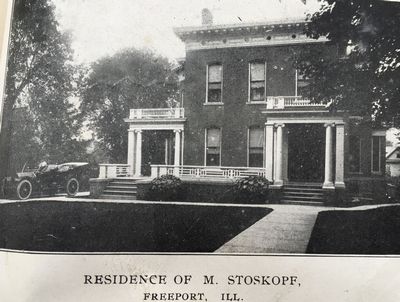
residence
of Michael Stoskopf
was at 437 W. Stephenson St.
torn down 1968 for First National Bank branch
Michael Stoskopf (1845-1919) was a prominent Freeport attorney.
His father and grandfather had been blacksmiths in Alsace, France. His father came to Freeport in 1841, and started both farming and blacksmithing. As he prospered, he bought large tracts of forested land. In 1846 he opened a carriage shop. By 1859 he was constructing buildings in Freeport and Stephenson County.
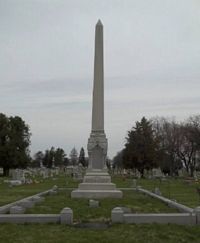
The Stoskopf family has a large plot with perhaps the tallest monument in City Cemetery, an obelisk that towers over the cemetery.
Michael worked in insurance while studying law, and was admitted to the bar in 1873. In 1888 he was first elected to the State Legislature, and served from 1888-1891, and again from 1895 to 1899.
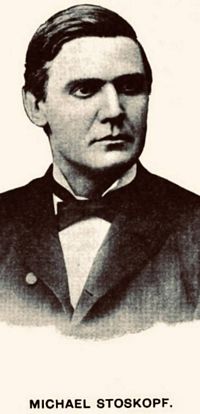
In 1893, Michael Stoskopf was the first president of the Freeport Water Company.
The home had very high ceilings, beautiful fireplaces, built in bookcases, and large metal tiles on the ceiling of the bathroom. It was an upstairs downstairs duplex for many years.
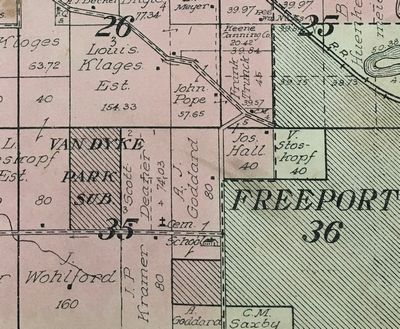
Close-up of Harlem Township West of Freeport
I've been researching and writing about Freeport since 2006, and sometimes I don't write about things because I can't find the answers. My questions so far are:
-
What school is shown at the southwest corner of Stephenson and Globe/Park? In the Freeport plat, this corner is shown as Highland Park, but on the Harlem Township plat it's a school.
-
Van Dyke Park Subdivision is shown where Park Hills Golf Courses are today. Was there a park there before the golf course was built in 1955?
-
At the north end of Globe/Park the road jogs northeast to meet Galena, and there is no road beyond that. Could that short section of Globe/Park be the mysterious Gypsy Lane?
-
Was the electricity generating plant on the north end of Manufacturers Island (plat book) or the foot of Main Street (1970 history)?
-
Where is the clock from the old Stephenson County Courthouse clock tower?
-
Where is the statue that was on top of the Old Colony Insurance building?
|
FREEPORT
STREET NAME CHANGES
|
|
|
1913
Plat Book
|
2021
Google Maps
|
| Louise | Park |
| Evans | (gone) |
| Gund | Hancock (south of river) |
| Taylor | E. Stephenson |
| Columbus | E. Shawnee |
| First | 13th |
| Second | 14th |
| Third | 15th |
| Fourth | 16th |
| Fifth | 17th |
| Sixth | 18th |
| Rayhorn | E. Wyandotte |
| Delaware | E. Pleasant |
| Rotzler Lane | S. Rotzler Ave |
| Gardener's Lane | S. Armstrong |
| Elizabeth | S. Hyde |
| Vine | S. Miami |
| First (Kilgrubbin) | (gone) |
| Second (Kilgrubbin) | (gone) |
| Nora (Kilgrubbin) | moved north 1500 feet |
| Queen (Kilgrubbin) | moved north 1500 feet |
| Lancaster (Kilgrubbin) | moved north 1500 feet |
| Allen (Kilgrubbin) | (gone) |
| Goodhue (Kilgrubbin) | (gone) |
| Cedarville Road | N. Van Buren |
| Fourth | extension of Ringold |
| Oak Place | Linden |
| Mechanic | State |
| Williams | Iroquois |
| Galena | Main |
| Calumet | Park Lane Drive |
| Read | S. Prairie |
| Grand | Moseley |
| Fifth | Avon |
| Union St. | Chicago Ave. |
| West St. | West Jefferson |
| First | Prentice |
| Second | Turner |
| Third | Warren |
| Fourth | Brewster |
| Fifth | Hunt |
| Sixth | Waddell |
| Smith | Langdon |
| Schofield | N. Stewart |
| Van Brocklin | N. Sunset |
| Hall | Hurd |
| Neese | (gone) |
| Lincoln Ave | Lincoln Blvd |
| Globe Ave | Park Blvd |
| Johnson | W. Harrison |
| Goddard | (gone) |
| Giddings | (gone) |
| Grant | W. Violet |
| Elizabeth St. | extension of W. Pleasant St |
| Shaffer | S. Harlem |
| Edward | Edwards |
Click
on any year in the chart below to see the class and other info,
such as postcards, people and events from that year.
|
1913
|
|||||||||
| 2010 | 2011 | 2012 | 2013 | 2014 | 2015 | 2016 | 2017 | 2018 | 2019 |
